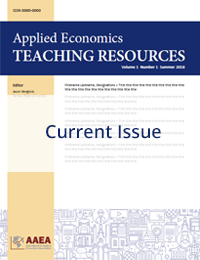Teaching and Educational Methods
Insights from Asynchronous Lecture Viewing Behavior
Michael Black
Texas A&M University
JEL Codes: A20, A22
Keywords: Asynchronous lectures, educations, learning experience
First Published Online: December 29, 2020
Volume 2, Issue 5
Abstract
The COVID-19 pandemic forced many applied economics courses to switch from synchronous, face-to-face instruction to an online format. A strategy for some instructors is to pre-record lectures for asynchronous viewing by students. I provide commentary on observed viewing behavior of pre-recorded lectures in an applied economics course and suggest ways to improve construction of asynchronous material. I observe students delaying viewing until assignments are due, skipping over lecture material and scrubbing to the “hands-on†portions of the videos, losing attention after approximately 20 minutes, and watching primarily on larger screens. Instructors may wish to consider posting lecture notes separately, with shorter videos covering only hands-on activities to improve student engagement.
References
Arbaugh, J.B. 2000. “Virtual Classroom versus Physical Classroom: An Exploratory Study of Class Discussion Patterns and Student Learning in an Asynchronous Internet-Based MBA Course.” Journal of Management Education 24:213–233.
Berrett, D. 2012. “How ‘Flipping’the Classroom Can Improve the Traditional Lecture.” The Chronicle of Higher Education 12:1–3.
Jaffee, D. 1997. “Asynchronous Learning: Technology and Pedagogical Strategy in a Distance Learning Course.” Teaching Sociology:262–277.
Khan, S. 2012. The One World Schoolhouse: Education Reimagined (Twelve).
Lau, K.H.V., P. Farooque, G. Leydon, M.L. Schwartz, R.M. Sadler, and J.J. Moeller. 2018. “Using Learning Analytics to Evaluate a Video-Based Lecture Series.” Medical Teacher 40:91–98.
Marmon, M., J. Gordesky, and J. Vanscoder. 2013. “Online Student Satisfaction: An Examination of Preference, Asynchronous Course Elements and Collaboration among Online Students.” In E-Learn: World Conference on E-Learning in Corporate, Government, Healthcare, and Higher Education. Association for the Advancement of Computing in Education (AACE), pp. 380–386.
“Microsoft Excel.” 2020. Microsoft Corporation.
Simpson, N. 2006. “Asynchronous Access to Conventional Course Delivery: A Pilot Project.” British Journal of Educational Technology 37:527–537.
Wieland, K. 2012. “Asynchronous Learning Networks.” In N.M. Seel, ed. Encyclopedia of the Sciences of Learning. Boston MA: Springer US.
Wu, D., M. Bieber, and S.R. Hiltz. 2019. “Engaging Students with Constructivist Participatory Examinations in Asynchronous Learning Networks.” Journal of Information Systems Education 19:9.
Articles in this issue
So You Want to Run a Classroom Experiment Online? The Good, the Bad, and the Different
Stephen N. Morgan, Misti D. Sharp, and Kelly A. Grogan
No Honor Among Cheaters: A Prisoners Dilemma Approach to Reduce Cheating in Online Classes
Jeffrey S. Young
Insights from Asynchronous Lecture Viewing Behavior
Michael Black
Adapting to the Nontraditional Classroom: Lessons Learned from Agribusiness and Applied Economics Classes
Erik Hanson and Cheryl Wachenheim
Reflections in Adjusting to a Global Pandemic from a Regional Agribusiness Program
J. Ross Pruitt, Rachna Tewari, and Joseph E. Mehlhorn
Considerations for Economic Instruction in the Era of COVID-19
Thomas P. Zacharias and Keith J. Collins


